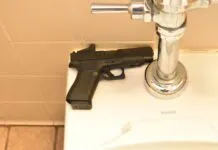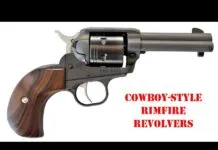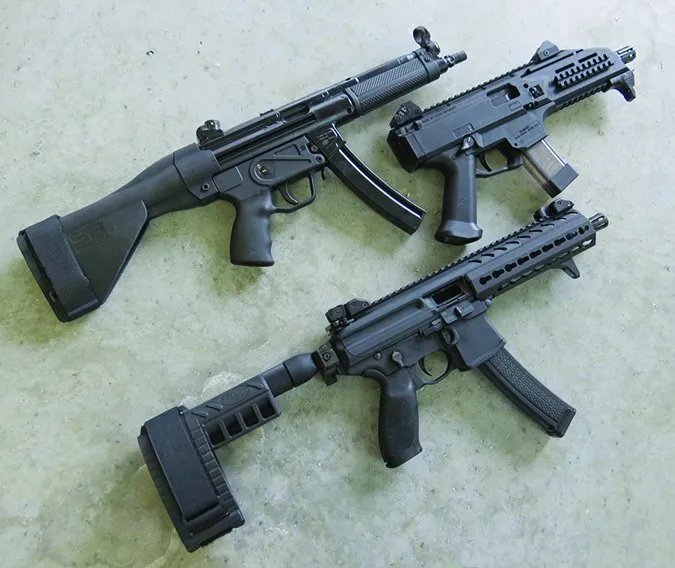
In the October 2016 issue, we tested three high-capacity 9mm Luger pistols and found them somewhat lacking in defensive scenarios, though we did enjoy shooting one, the MPA Defender, which was sized more like a regular pistol than the carbine-like SIG MPX and which functioned better than an Uzi Mini Pro. But there are an increasing number of pistols that, save for a couple of features, function more like Short-Barreled Rifles (SBRs), which are controlled by much more stringent regulations under the National Firearms Act and are vastly more expensive and hard to get. The SIG MPX-PSB, for example, is similar to the unit we tested last October except it comes with a Stabilizing Brace, thus the “SB” in the name, compared to the “P” designation we initially tested.
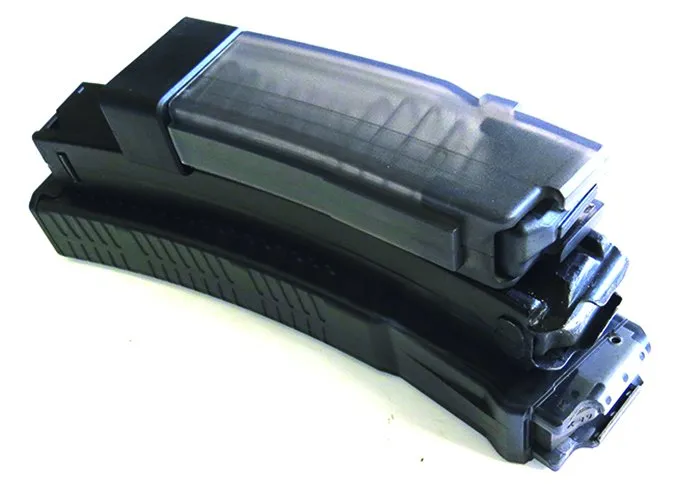
This round, we found products more alike in size to the SIG Sauer MPX-PSB, namely, the CZ Scorpion EVO 3 S1 and the Zenith Firearms MKE Z-5RS with SB Brace. The Zenith and SIG came with a stabilizing brace, while the CZ did not, but it could be purchased separately. The SIG, CZ, and Zenith are tactical looking firearms because they all have a military ancestry that is especially noticeable due to the magazine mounted in front of the trigger guard and not in the grip. The three pistols tested are all semi-automatic, require two hands to shoot with any degree of accuracy, use high-round-capacity magazines compared to typical full-size handguns, and have the ability to be fired with a stabilizing brace. These pistols also represent three different operating mechanisms: the SIG uses a short push-rod gas system; the CZ a simple blowback system, and the Zenith a delayed roller-block mechanism. During firing, we noticed big differences in the mechanisms in both manual operation and cycling when fired, which we will get into. The ergonomics and controls differed as well, yet we found our ramp-up time transitioning between handguns to be short.
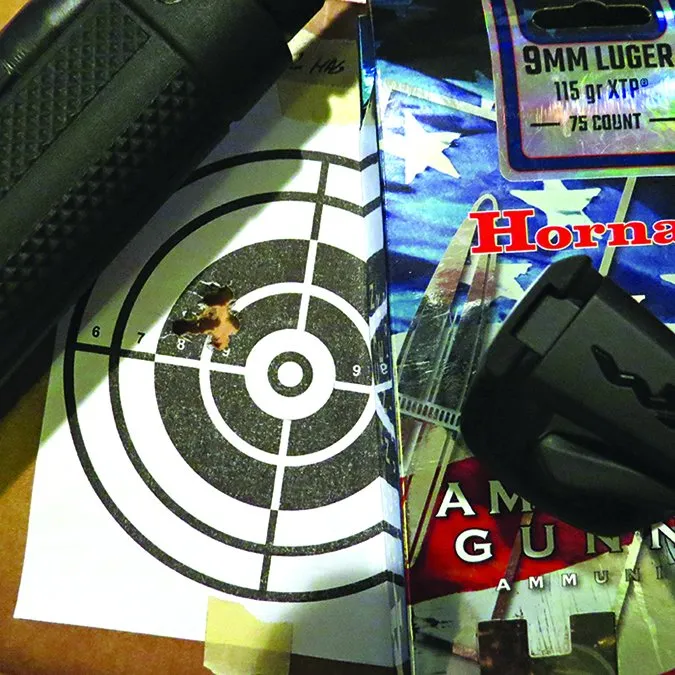
Initially, there is an awkwardness shooting these pistols because they feel like an SBR yet have no stock for a steady aim, and they are too heavy to fire in a Weaver, Isosceles, or hybrid stance with a two-hand hold like a typical handgun. We believe adequate range time and proper training is needed to master these pistols.
Most important, we wondered if, out of the box, these similar, yet different, pistols would work as home-defense choices. In our opinion, the upside of these three pistols is that they offer high magazine capacities, decent accuracy, and a lot of shooting fun. Yes, these pistols can make empty brass very quickly. On the downside is cost. Yes, you can purchase a lot less gun for a lot less money and achieve the same self-defense goal as what this trio delivers, we believe. Still, we looked forward to seeing what each firearm could do at the range.
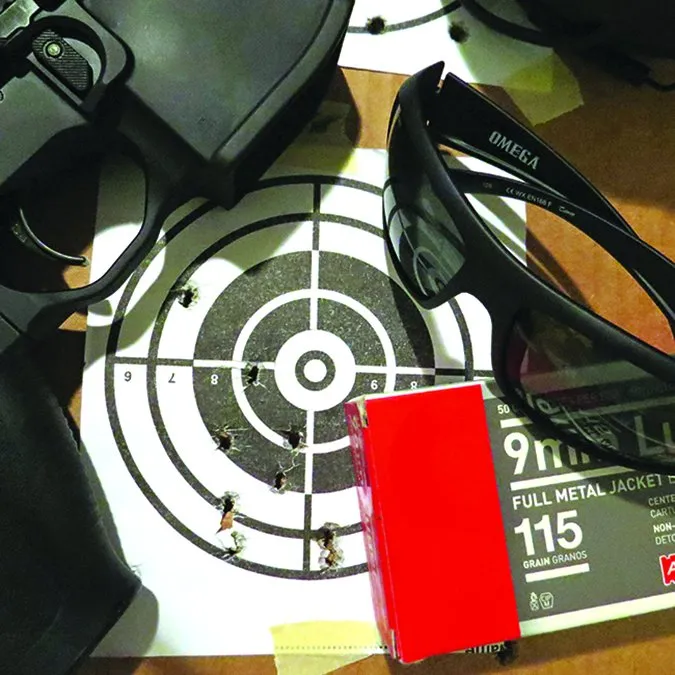
How We Tested
We purchased 9mm ammo off the shelf at a local sporting goods store in North Carolina, Eastern Outfitters, choosing Hornady American Gunner 115-grain XTP jacketed hollow points ($47/75 rounds), Aguila 115-grain FMJs ($16/50), and Winchester Train 147-grain FMJs ($17/50). We wanted a mix of bullet weights and bullet types to see if roundnose FMJs had an advantage over hollowpoint ammo in feeding. In short, we found all three pistols chewed through the ammo equally well with no issues.
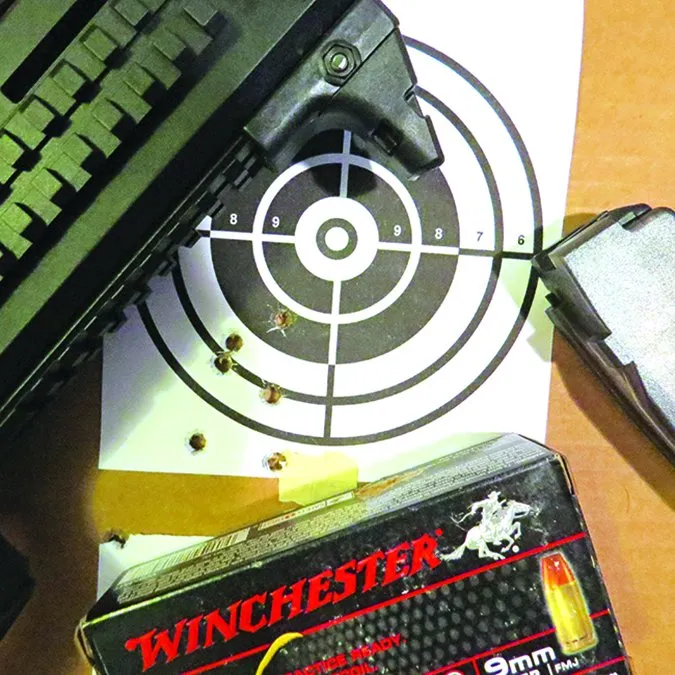
We fired for accuracy using open sights and a benchrest at targets set at 25 yards, and found these pistols could shoot some pretty nice groups. After accuracy testing, the pistols were fired using a two-hand hold with and without a sling. We liked using a sling since it gave shooters more stability. We also fired the SIG and Zenith using the stabilizing braces included with the pistol. In the past, we have found we prefer to use a stabilizing brace to achieve a cheek weld in lieu of strapping to our arm. We also fired the pistols using our support hand to grasp the front of the magazine well and the magazine. We wanted to know if applying tension to the magazine would throw them off. Nope. One thing to remember with these pistols, they are not made for bullseye shooting, but instead are able to rapidly squirt lead downrange. A box of 50 rounds can go fast with these pistols. Here is what we found out about them in more detail.
9mm Luger Range Data
| Hornady American Gunner 9mm Luger 115-gr. XTP | Zenith MKE Z-5RS w/ SB Brace | SIG Sauer MPX-PSB | CZ-USA Scorpion EVO 3 S1 |
| Average velocity | 1193 fps | 1198 fps | 1239 fps |
| Muzzle energy | 363 ft.-lbs. | 367 ft.-lbs. | 392 ft.-lbs. |
| Smallest group | 0.38 in. | 0.64 in. | 0.51 in. |
| Average group | 0.43 in. | 0.96 in. | 1.03 in. |
| Winchester Train 9mm Luger 147-gr. FMJ | |||
| Average velocity | 1025 fps | 1012 fps | 1034 fps |
| Muzzle energy | 343 ft.-lbs. | 334 ft.-lbs. | 349 ft.-lbs. |
| Smallest group | 0.80 in. | 0.85 in. | 0.56 in. |
| Average group | 0.88 in. | 1.1 in. | 1.05 in. |
| Aguila 9mm Luger 115-gr. FMJ | |||
| Average velocity | 1214 fps | 1224 fps | 1244 fps |
| Muzzle energy | 376 ft.-lbs. | 383 ft.-lbs. | 395 ft.-lbs. |
| Smallest group | 0.40 in. | 0.54 in. | 0.80 in. |
| Average group | 0.61 in. | 0.87 in. | 1.21 in. |
| To collect accuracy data, we fired five-shot groups from a bench using a rest. Distance: 25 yards with open sights. We recorded velocities using a ProChrono digital chronograph set 15 feet from the muzzle. | |||
CZ Scorpion EVO 3 S1 91351 9mm Luger, $849
GUN TESTS GRADE: B-
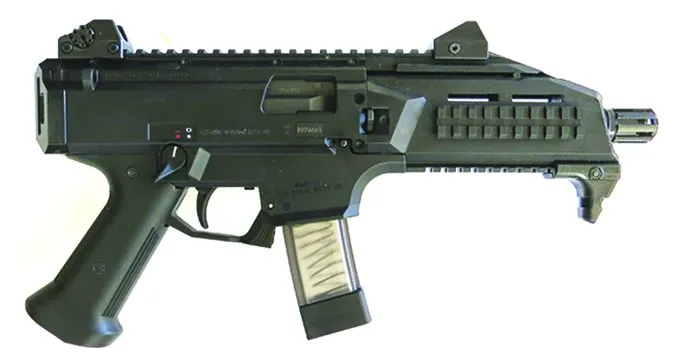
The Scorpion offers a lot of pistol for a low cost, performing well out of the box and is very customizable with aftermarket parts. We lowered the grade due to the safety selector bashing knuckles on recoil.
| ACTION TYPE | Blowback semi-auto |
| OVERALL LENGTH | 16 in. |
| OVERALL HEIGHT | 9.4 in. |
| MAX WIDTH | 3.8 in. |
| WEIGHT UNLOADED | 5 lbs. |
| WEIGHT LOADED | 5.5 lbs. |
| SLIDE | Steel |
| RECEIVER | Polymer |
| BARREL | 7.7 in., 1:10 twist |
| MUZZLE DEVICE | CZ flash hider, 1/2×28 LH threads |
| BRACE | None |
| PISTOL GRIP | Smooth polymer |
| GRIP THICKNESS (max) | 1.25 in. |
| GRIP CIRCUMFERENCE (max) | 5.5 in. |
| HANDGUARD | Polymer, railed |
| MAGAZINE | (2) 20-rd. polymer |
| REAR SIGHT | Steel, folding, windage adjustable |
| FRONT SIGHT | Steel, folding, elevation adjustable |
| SIGHT RADIUS | 9.5 in. |
| TRIGGER | 8.4 lbs. |
| SAFETY | Ambidextrous, 2-position lever |
| DUST COVER | None |
| WARRANTY | Limited 5 year |
| TELEPHONE | (800) 955-4486 |
| MADE IN | Czech Republic |
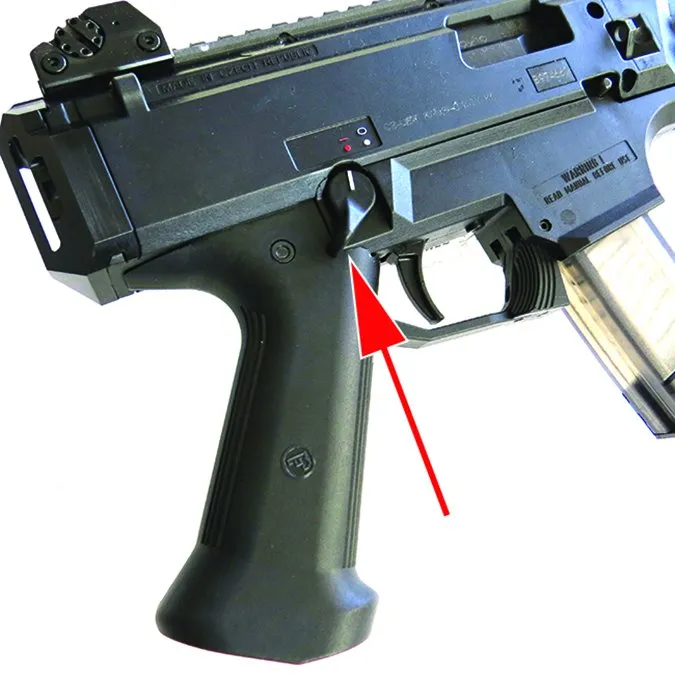
The Scorpion EVO 3 S1 has a reputation to live up to. The original Skorpion vz. 61 was a select-fire blowback operating pistol chambered in 32 ACP with cyclic rate of 850 rounds per minute. The Scorpion EVO 3 S1 is an updated design that also uses a blowback mechanism, but it has a fiber-reinforced polymer receiver in lieu of stamped steel. The receiver of the EVO 3 S1 is made of two polymer halves that sandwich together with a trigger group that snaps underneath and a handguard that slides over the barrel. The barrel is equipped with a CZ flash hider attached via 1⁄228 threads so you can fit either 1⁄228 or 181 accessories to the muzzle. The Scorpion has a blocky look that makes it look heavier and larger than it actually is, our shooters noted.
The pistol features an ambidextrous thumb safety and magazine release. The safety rotates to either “safe” or “fire” mode. Some shooters found the safety selector rapped against their knuckles when firing. It was also difficult to flip on/off with the thumb of the shooting hand. HB Industries sells a Right Safety Delete V2 ($13; HBIndustries.net) that removes the right-side safety lever. We would invest in this aftermarket product if we owned the Scorpion. The magazine release is built into the front of the trigger guard with coarse serrations, so your trigger finger can easily dump a magazine, or you can use the thumb of your supporting hand. The cocking handle can also be swapped for either a right- or left-hand shooter. It operates like an HK MP5 and the Zenith. It is easy to operate and lock back. Not a lot of strength is required to cock the pistol or lock it back. The adjustable pistol grip allows you to increase or decrease the distance from the back strap to the trigger face. The grip is relatively smooth on the sides, but the front and rear straps are serrated. The grip butt is flared so your hand does not slide off the grip, even in rapid fire. The bolt release is located on the left side of the pistol in a similar location as an AR-15 bolt-release button.
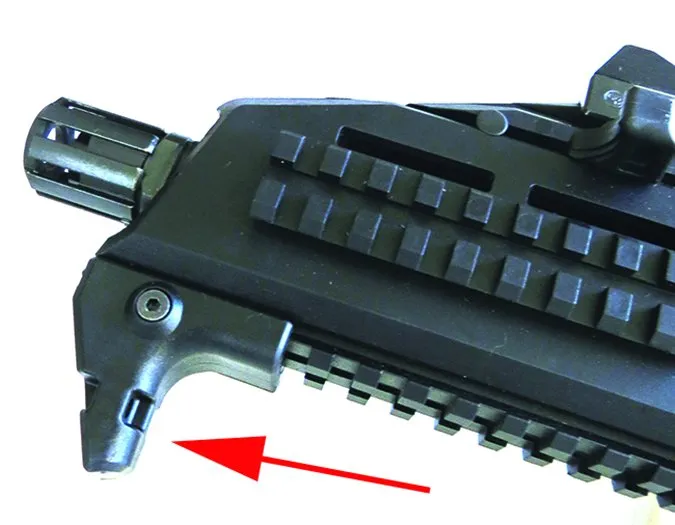
The top side features an 11-inch Picatinny-style rail with steel front and rear sights attached. The front post is adjustable for elevation and is protected by wings. A tool comes with the pistol to adjust the front sight. The rear sight has four aperture choices that rotate and click into place and is adjustable for windage with a flat-blade screwdriver or a cartridge rim. The shooter-facing side of the sights are serrated to cut glare. We liked these sights. The Picatinny-style rail also allows plenty of options if you want to mount a red dot or reflex sight. The handguard has rails at the 3, 6, and 9 o’clock positions if you wanted to mount a tactical light or laser pointer. A hand stop is located at the very end of the handguard so your supporting hand does go past the muzzle. You can also use the stop to push the pistol toward the target while your shooting hand pulls back. This is another way to fire these pistols more steadily. The trigger has a slight curve and is coarsely serrated. The trigger guard was also plenty large, so the EVO can be operated with gloved hands.
In hand, the Scorpion was well balanced, our shooters said. We could shoot this pistol one handed, but fatigue would set in quickly—as with all three pistols. The ergonomics were good, except for the safety selector. The Scorpion was the most compact and lightest of the three pistols. An adapter kit ($100; shop.CZ-USA.com) can be purchased that is a buffer tube that a barrel attaches to a SIG brace ($139-$148; SIGSauer.com). Purchasing the extension tube and brace brings the price of the Scorpion closer to the price of the SIG. Two 20-round magazines and a bore-snake cleaning rod is included with the pistol. Additional 30-round ($20) and 10-round ($18) magazines are available from the CZ shop.
The magazines are translucent polymer so you can easily see remaining ammo. We found the magazines easy to load. The feed lips of the magazine are polymer, and we did not see any significant wear.
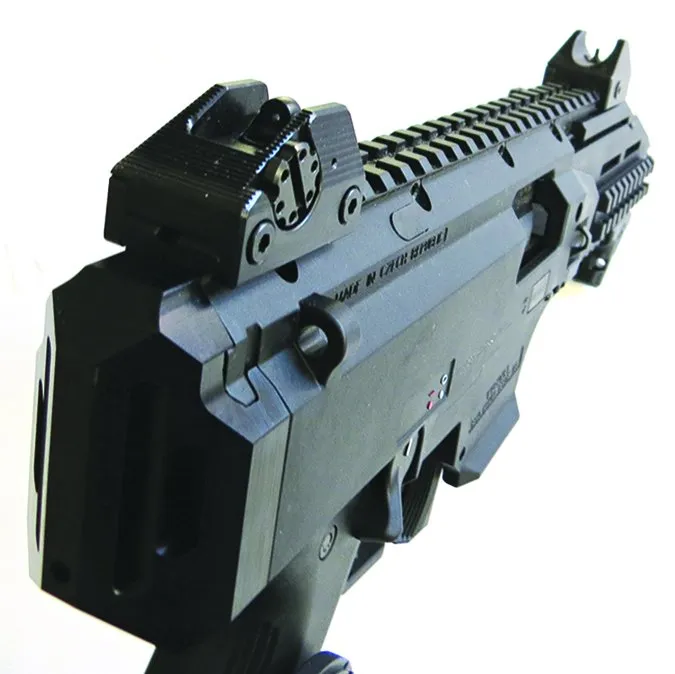
All ammunition cycled flawlessly through the Scorpion. Magazines seated easily and with authority. The pistol was easy to cock—the easiest of the three tested—since you could pull back on the cocking lever with your support hand and provide good resistance with the firing hand. We fired the Scorpion with and without a sling and we felt the sling offered a steadier aiming position.
Benchrest accuracy was very good, averaging about 1 inch for five rounds at 25 yards. One tester consistently grouped five shots at about 0.5 inch with the Hornady American Gunner and Winchester Train ammo. We did notice the Scorpion had more felt recoil than the other two pistols. The pistol was easy to adapt to and manipulate. Reloads were fast and smooth. The bolt locked back on the last shot fired. We also like that the pistol was easy to shoot with both eyes open. We would prefer a lighter trigger; our sample measured 8.4 pounds, but our accuracy was good, even with the heavy trigger pull.
Our Team Said: Recoil was more noticeable due to the blowback mechanism. Some testers did not like the ambidextrous safety selector bumping their knuckle during fire and graded the Scorpion down for this reason. It was easy to cock and the operating handle was reversible. It was the least expensive, yet held its own with the more expensive pistols, and is very adaptable for mounting optics, stabilizing braces and other accessories. In our opinion, this is a good starter pistol due to the cost. We also searched the web and found numerous aftermarket parts available.
SIG Sauer MPX-PSB #MPX-P-9-KM-PSB 9mm Luger, $1700
GUN TESTS GRADE: B+
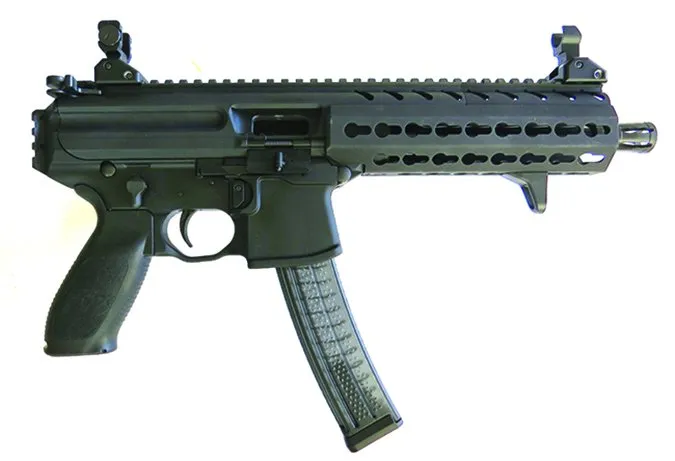
The SIG MPX-PSB performed well, and because it was an AR-15/style platform, ramp-up time was short. The short-stroke mechanism produced minimal felt recoil.
| ACTION TYPE | Semi-auto short-stroke pushrod gas system |
| OVERALL LENGTH | 16.85 in. |
| OVERALL LENGTH w/ BRACE | 25.75 in. |
| OVERALL HEIGHT | 11 in. |
| MAX WIDTH | 2 in. |
| WEIGHT UNLOADED | 6 lbs. |
| WEIGHT LOADED | 6.8 lbs. |
| UPPER RECEIVER | Forged 7075-T6 aluminum |
| LOWER RECEIVER | 7075-T6 aluminum |
| BARREL | 8 in., 1:10 twist |
| MUZZLE DEVICE | A2, 13.5×1 LH threads |
| BRACE | SIGTAC SBX |
| PISTOL GRIP | SIG AR style |
| GRIP THICKNESS (max) | 1.25 in. |
| GRIP CIRCUMFERENCE (max) | 5.5 in. |
| HANDGUARD | SIG aluminum KeyMod |
| MAGAZINE | (1) 30-rd. polymer |
| REAR SIGHT | Steel, folding, windage adjustable |
| FRONT SIGHT | Steel, folding, elevation adjustable |
| SIGHT RADIUS | 12.5 in. |
| TRIGGER | 7 lbs. |
| SAFETY | Ambidextrous, 2-position lever |
| DUST COVER | Yes |
| WARRANTY | Limited lifetime |
| TELEPHONE | (603) 610-3000 |
| WEBSITE | SIGSauer.com |
| MADE IN | USA |
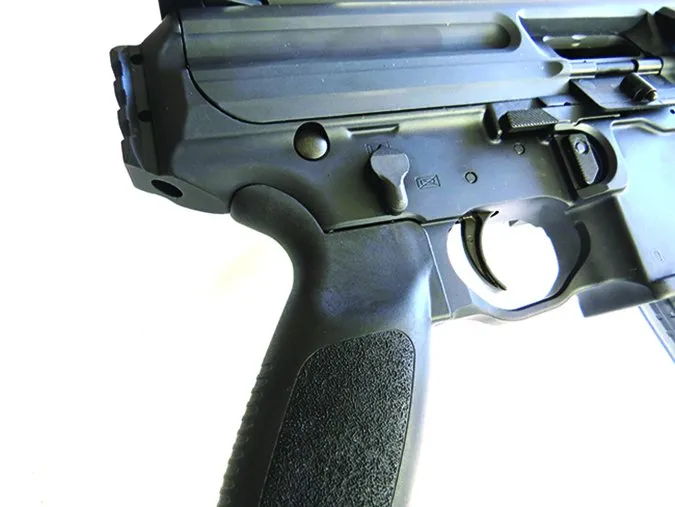
The MPX-PSB is similar to the MPX-P (B+) we tested a few issues ago. Based on an AR-15 style platform, the MPX series uses a closed, fully locked short-stroke, pushrod gas system mechanism. AR shooters adapted quickly to the SIG since controls and handling are similar. The MPX-PSB is built with an upper and lower receiver, so takedown is similar to an AR-15. The quality workmanship was apparent in the SIG, and that is what we expected from this manufacturer. The matte-black finish was well executed, and there was no wiggle between lower and upper receivers.
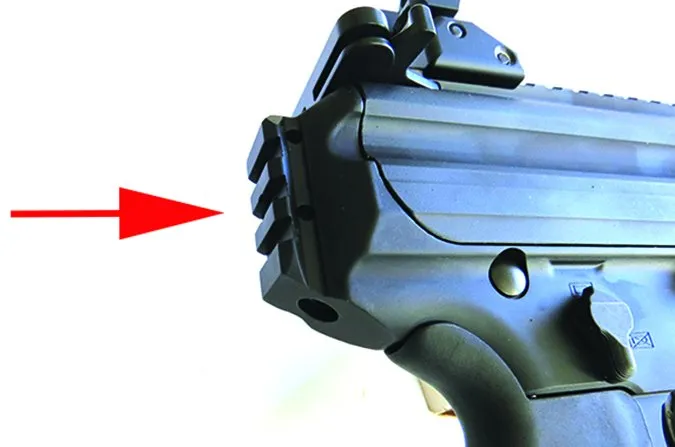
In the lower, the bolt release, magazine release, and safety selector are ambidextrous and easy to manipulate. The lever and button touch surfaces are finely serrated. The grip is equipped with SIG’s comfortable textured side panels and coarsely serrated front and rear straps. It also offers a storage compartment for spare batteries. The magazine well is well flared to suck in the translucent magazine. The magazine was easy to load, even to the 30th round, and had a pebble texture on the sides with serration on the front and rear edge. Not enough to snag in a mag pouch, but enough for a sure grip. It also had metal feed lips. We like that we could see how much was still in the tank due to the translucent polymer. The trigger guard is over sized and glove friendly. The rear of the lower has a quick-detach socket and a small rail to attach a brace. The trigger is single stage and broke at about 7 pounds on average.
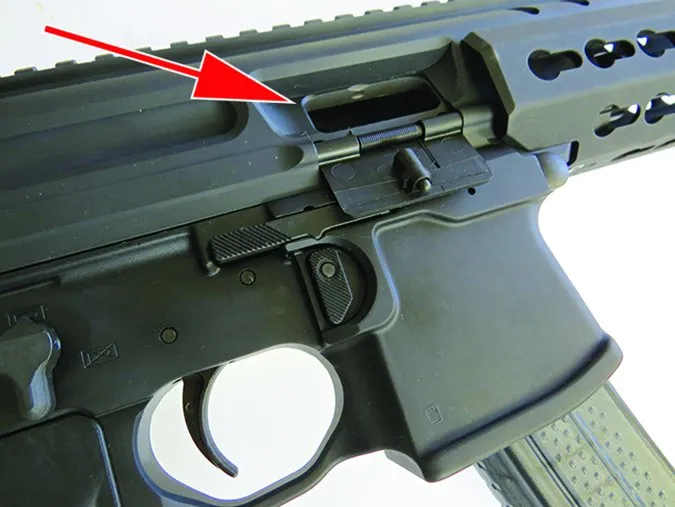
The upper offers 14 inches of top rail where the folding front and rear sights attach. The sights deploy and fold without pressing a button. A detent keeps them up or down. There are two rear apertures and is adjustable from windage; the front sight is a post adjustable for elevation. It is protected by wings. Since buttons are not required to deploy or stow the sights, the sights can easily fold back if the firearm is accidentally dropped. You also need to be aware that in a tight environment—like getting out of a vehicle or pushing through brush, the sights could accidentally be folded back. We liked the sights, as can be seen in the range-accuracy data, but we’d prefer if they locked in place when stowed and when deployed. The KeyMod handguard allows the user to mount accessories on five different rails. A hand stop is mounted behind the muzzle. The barrel is free floated and is capped off with an A2-style flash hider that can be removed to add your choice of muzzle device. The ejection port is sized to fit a 9mm round and includes a dust cover. The SIG uses a oversized charging handle similar to an AR-15. Cocking the weapon took more effort than with the Zenith or CZ, but was the same when compared to nearly any AR-15 pistol. Since your support hand and firing hand are nearly on top of each other when cocking the SIG, there is enough leverage, so cocking is rather easy. The MPX-PSB is solidly built and is a hefty piece, but it is less bulky than the CZ, we thought.
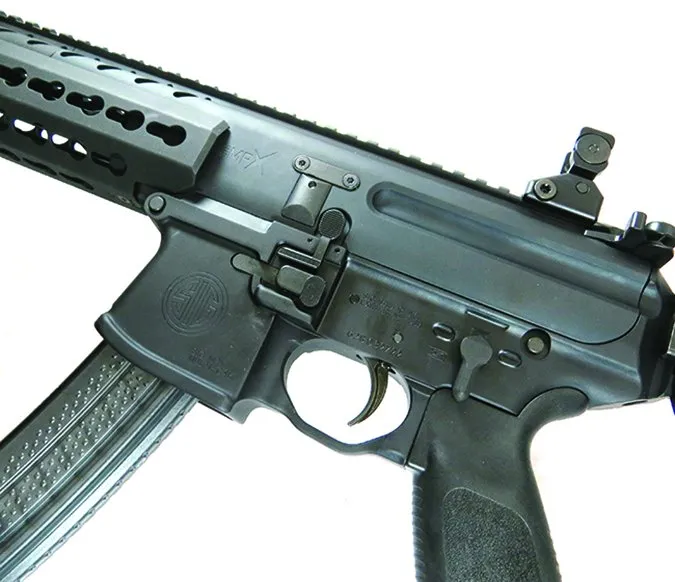
The MPX-PSB comes well equipped and includes the folding stabilizing brace, QD sling loop and sling, and one magazine. We would have liked an additional magazine, but that’s just a nitpick. Additional magazines cost $69 (SIGSauer.com), which we feel is pricey. The SIG was easy to disassemble and clean—just like an AR-15.
At the range the SIG showed some excellent accuracy. With Aguila 115-grain FMJs, our smallest group measured 0.54 inches. The other ammo brands were just slightly larger. On average, we found the SIG capable of 5-shot groups under 1 inch. We feel that with any of these pistols, a red-dot or reflex sight would shrink groups even more, but we think with the good iron sights on these pistols and the distance they are most likely to be used at, an optic is not required.
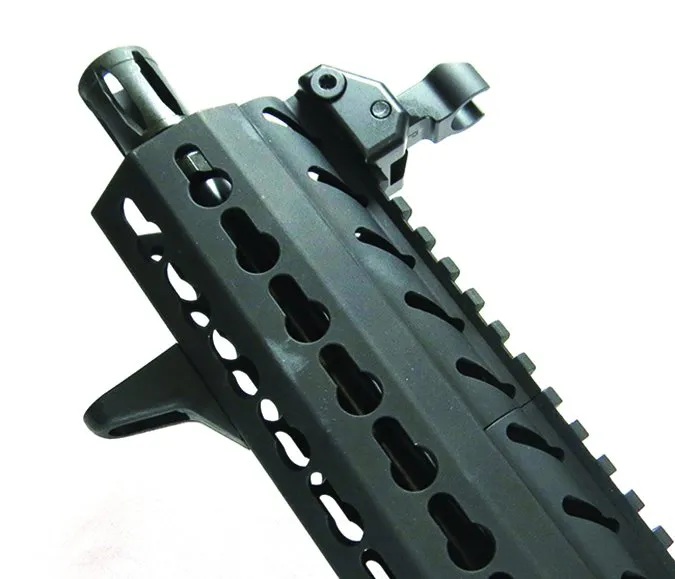
We ran the SIG with and without the brace, and testers were split on whether it was required. The nice feature of the SIG is the brace can be folded out of the way, which we all appreciated. The pistol can be fired with the brace folded or extended. Reloads were slick and fast since the SIG had a gaping mag well. The bolt locked back on the last round fired, so inserting the magazine with our support hand and slapping the bolt-release button with our support-hand thumb was smooth and fluid. Also, the polymer of these magazines seemed to be slicker against the metal. All controls worked with authority and ease. Some testers could get into a nice rhythm with the SIG since they could grasp the handguard like they would on an AR-15. We ran the SIG hard—as we did with all the pistols—firing one and two handed, side ways, upside down. Nothing jammed in the SIG nor the other pistols.
Our Team Said: The transition to the MPX-PSB from an AR-15 was smooth for testers familiar with the AR-15 platform. The SIG was well built, tight with no wiggle. It came with a lot of accessories in the box, but we would have liked an additional magazine. Recoil was very manageable. If you are an AR-15 guy/gal, then the SIG would be the obvious choice.
Zenith Firearms MKE Z-5RS with SB Brace MKZ5RSA009BK 9mm Luger, $2050
GUN TESTS GRADE: A-
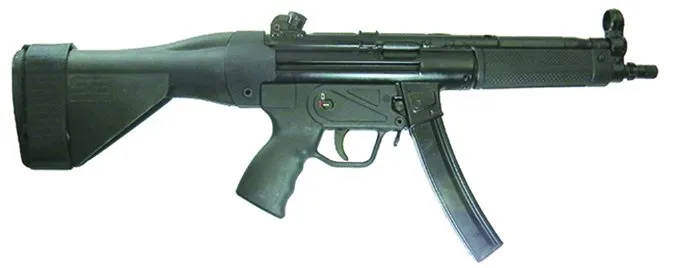
If you have always wanted an H&K MP5, then the Zenith is a good, less costly choice. Smooth operating with minimal recoil and excellent accuracy, this old-school pistol performs.
| ACTION TYPE | Semi-auto; roller-delayed blowback |
| OVERALL LENGTH | 17.9 in. |
| OVERALL LENGTH w/ BRACE | 25.75 in. |
| OVERALL HEIGHT | 8.5 in. |
| MAX WIDTH | 1.9 in. |
| WEIGHT UNLOADED | 6.1 lbs. |
| WEIGHT LOADED | 6.9 lbs. |
| UPPER RECEIVER | Stamped steel |
| LOWER RECEIVER | Polymer |
| BARREL | 8.9 in., 1:10 twist |
| MUZZLE DEVICE | None, 1/2×28 LH threads |
| BRACE | SB tactical pistol stabilizing brace |
| PISTOL GRIP | Textured polymer |
| GRIP THICKNESS (max) | 1.16 in. |
| GRIP CIRCUMFERENCE (max) | 5.5 in. |
| HANDGUARD | Textured polymer |
| MAGAZINE | (3) 30-rd. steel |
| REAR SIGHT | Steel, elevation/windage adjustable |
| FRONT SIGHT | Steel, protected post |
| SIGHT RADIUS | 13 in. |
| TRIGGER | 5.5 lbs. |
| SAFETY | Ambidextrous, 2-position lever |
| DUST COVER | None |
| WARRANTY | Limited 5 year |
| TELEPHONE | (434) 202-7790 |
| WEBSITE | ZenithFirearms.com |
| MADE IN | Turkey |
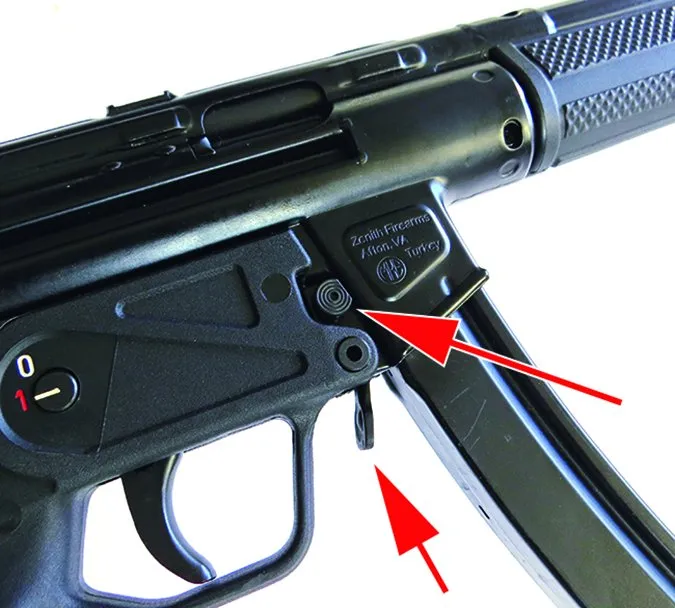
The Zenith Firearms MKE Z-5RS is not a clone, but is instead an H&K-licensed copy made in Turkey. It is a civilian version of the iconic H&K MP5, one of the most widely used submachine guns in the world. One of our evaluators was a former SWAT member and MP5 instructor. He could write his name in the dirt with an full-auto MP5 and liked converting AR-15 fans to MP5s.
The MP5 and MKE Z-5RS both employ a delayed roller-block mechanism. In this system, basically before a cartridge is fired, the bolt carrier and bolt are temporarily locked into the trunnion as rollers engage the locking piece. The bolt remains locked until the bullet leaves the barrel and the pressure drops, then the rollers disengage and the bolt carrier moves rearward by the force of the recoil. The SIG short-stroke piston uses gas from a fired cartridge to operate the piston and push the bolt rearward. The CZ’s blowback unit uses the force of a fired cartridge to throw back the bolt.
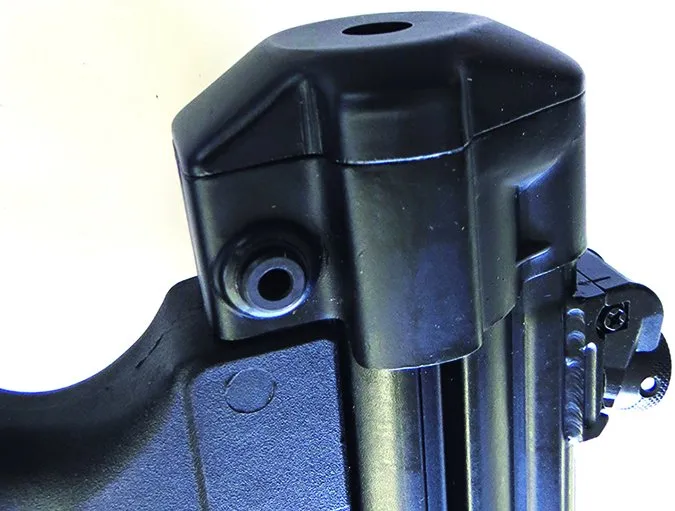
The MP5, hence the Zenith MKE Z-5RS, was originally designed in the early-to-mid-1960s—yes, this is an old-school firearm constructed of stamped sheet steel that is welded to form the receiver. Unlike the clean molded polymer receiver of the CZ or the forged and CNC machined receivers of the SIG, the Zenith is not as refined aesthetically. You can seen hand welds, but the finish was good. The Zenith was the heaviest and the longest of the three pistols, but has a small profile. It is like a pipe with a pistol grip. In the hard-plastic carry case was a factory cleaning kit, two extra takedown pins, sling, three 30-round steel-body magazines, and an SB Tactical stabilizing brace. This brace is similar to the SIG, with a hook and loop strap attaching it to your arm, which we tried, and prefer to use the brace as a cheek weld.
The upper receiver houses the barrel, operating mechanism, and magazine well. A polymer trigger group snaps into the receiver, and a butt cap keeps the pieces together. On the top side is a rear sight drum that has four apertures and is adjustable for windage and elevation. The outer edge of the drum is knurled for a sure grip and to cut glare. The front-sight post is enclosed and protected in a ring. Excellent sights in our opinion. What the Zenith lacks is a Picatinny rail. Aftermarket clamp-style mounts cost anywhere from $20 (Model MNT-P669; Leapers.com) to $400 (Model HKP17660; HKParts.net). The 8.9-inch barrel has a three-lug quick attachment and a 1⁄2×28 threaded muzzle. A cap protects the threads. The polymer forend has a coarse texture and is skinny, so it is easy to grasp. On the left side is the cocking handle with a rubber knob. Similar to the CZ, but not ambidextrous like the CZ, it has a longer stroke. Also, it took a little more effort to cock and lock back the bolt with the Zenith than the CZ. The Zenith has two magazine releases: a button for right-hand shooters with long fingers and an ambidextrous paddle a lot like one you might find on an AK. We found ourselves using the paddle since it was faster to manipulate. The magazines are made of steel with a steel follower and floor plate pad and were the easiest magazines we have ever loaded. The mag well is smaller with the Zenith, so extra care is needed to align the mag and the opening.
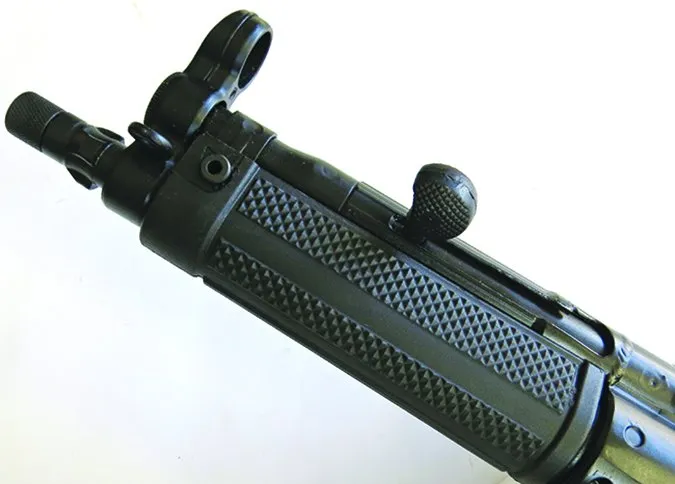
The polymer trigger group is a one-piece grip and trigger guard that offers good ergonomics. The safety selector is located on the left side and is easily operated with the thumb of a right hand shooter. The status of the safety lever is clearly indicated on both sides of the pistol. The trigger is smooth and had a 5.5-pound pull weight. The trigger and the safety selector can easily be removed from the trigger group housing. In fact, the Zenith came apart easily. Remember, there is a reason Zenith provides extra pins as part of the package. They are easily lost in the field or in a work shop, a limitation of the old design.
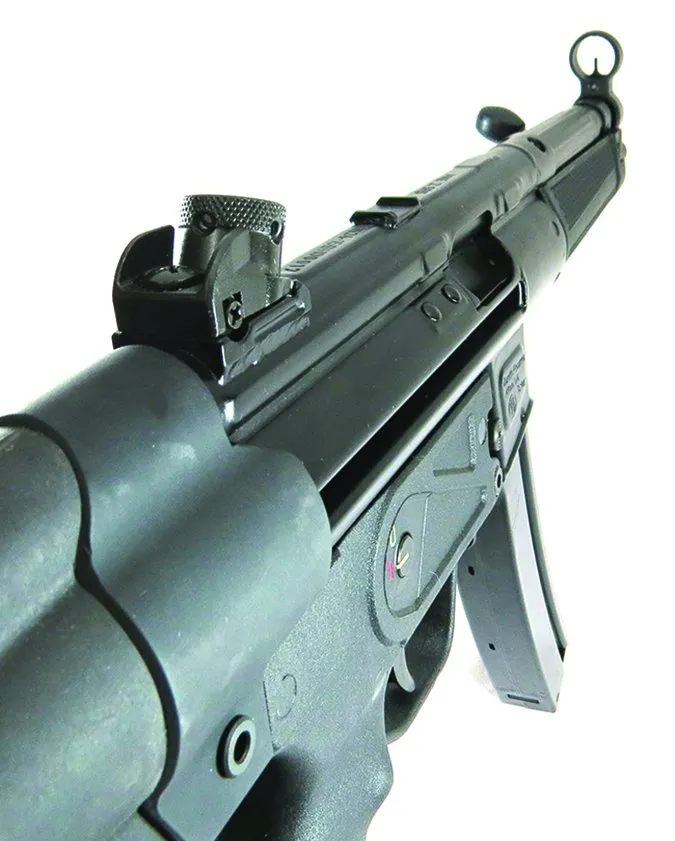
At 25 yards we found the Zenith pulled away from the pack. Recoil felt like 22 LR rimfire or pellet gun. Minimal to say the least, and the mechanism operated super smoothly. By far much smoother than the SIG, which we thought was smooth, and the CZ. This is the difference in the mechanisms, and in our opinion, it explains the difference in the cost of the pistols. One tester was able to get 10 rounds in a group that measured 0.38 inches at 25 yards using a rest with the Hornady American Gunner ammo. Sweet. In fact, on average, all the ammo grouped five shots under 1 inch. Sweet again. The Zenith had the most surgical accuracy of the pistols tested. Using the brace and firing for speed, we could control the MKE Z-5RS better than the other pistols. The pistol was also easy to operate, and even though it was the longest and heaviest of the pistols tested, it felt more lithe in the hand. We had no issues with the Zenith. It is easy to understand why the H&K MP5 is still in use with many military and LE groups around the world.
Our Team Said: If you are an H&K MP5 fan, then the Zenith is your option. The cost is staggering—more than double the CZ—and we did downgrade it appropriately. The smooth operation, minimal recoil, and accuracy endeared testers to the Zenith. We liked the accessories that came with it.
The Legalities of SIG Sauer’s Pistol Stabilizing Brace
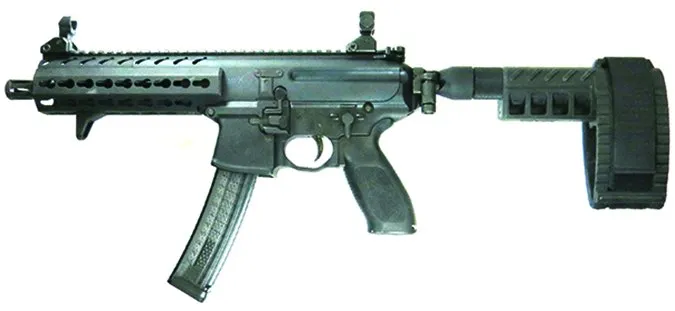
SIG Sauer’s SBX Pistol Stabilizing Brace, shown in the three adjacent images attached to the MPX, is an update to the SB15 Pistol Stabilizing brace, a shooter’s aid that is designed to improve the single-handed shooting performance of buffer-tube-equipped pistols. The SBX features a slimmer design with a thicker strap for extra stability. Made from elasto-polymer, the SB15 is manufactured to fit all pistols equipped with an AR-style buffer tube 1.0 to 1.2 inches in diameter. The Pistol Stabilizing Brace uses the operator’s forearm to provide stable support, minimizing spin and shift. A flexible cuff with two adjustable nylon straps allows the SB15 to be custom-fit to any user. SIG says the device is “ATF compliant,” which they explain as, “ATF has reviewed this product and determined that attaching the SB15 to a firearm does not alter the classification of the firearm or subject the firearm to NFA control.” It’s $95 if sold separately.
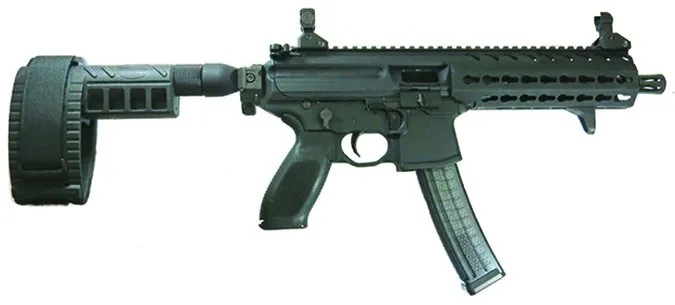
A January 2015 ATF letter signed by Max M. Kingery, Acting Chief of the Firearms Technology Criminal Branch at ATF reads, “These devices are described as ‘a shooter’s aid that is designed to improve the single-handed shooting performance of buffer tube equipped pistols.’ The device claims to enhance accuracy and reduce felt recoil when using an AR-style pistol.
“These items are intended to improve accuracy by using the operator’s forearm to provide stable support for the AR-type pistol. ATF has previously determined that attaching the brace to a firearm does not alter the classification of the firearm or subject the firearm to National Firearms Act (NFA) control. However, this classification is based upon the use of the device as designed. When the device is redesigned for use as a shoulder stock on a handgun with a rifled barrel under 16 inches in length, the firearm is properly classified as a firearm under the NFA….
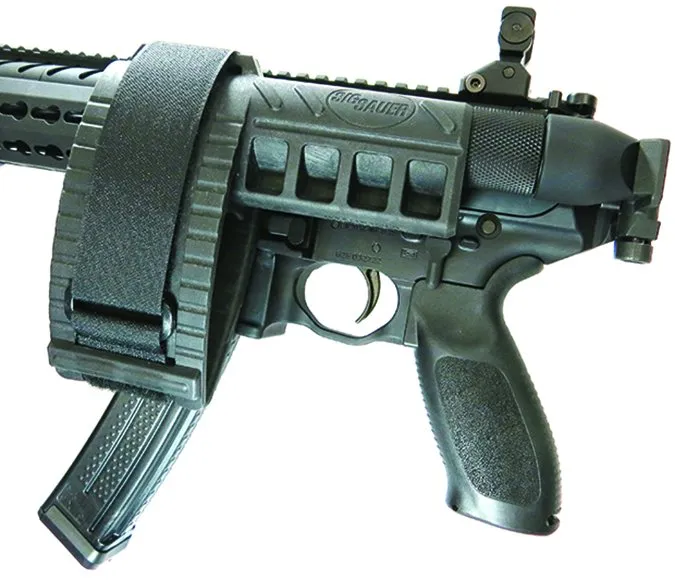
“The pistol stabilizing brace was neither “designed” nor approved to be used as a shoulder stock, and therefore use as a shoulder stock constitutes a ‘redesign’ of the device because a possessor has changed the very function of the item. Any individual letters stating otherwise are contrary to the plain language of the NFA, misapply Federal law, and are hereby revoked.
“Any person who intends to use a handgun stabilizing brace as a shoulder stock on a pistol (having a rifled barrel under 16 inches in length or a smooth bore firearm with a barrel under 18 inches in length) must first file an ATF Form 1 and pay the applicable tax because the resulting firearm will be subject to all provisions of the NFA,” the letter concluded.
Written and photographed by Robert Sadowski, using evaluations from Gun Tests team testers. Special thanks to Eastern Outfitters of Hampstead, NC, for their assistance.



